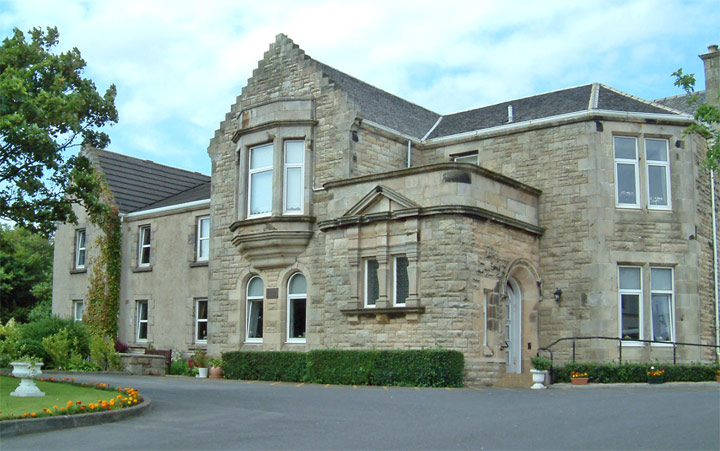
Abbotsford Nursing Home, Eglinton Road 2
30
June 2003
Abbotsford Nursing home opened on 20 February
1986 with 24 beds. It now has 35 beds. Before it became a nursing home, it was
owned by Doctor Beaton, a local general practitioner. He bought the house from
the Hogarth family who ran the Hogarth Shipping Company. The house was originally
called the 'The Garth' and was built in 1898.
On 11 December 1921, history was made in Ardrossan when the first radio broadcast
from the United States of America was received in a field near Abbotsford.
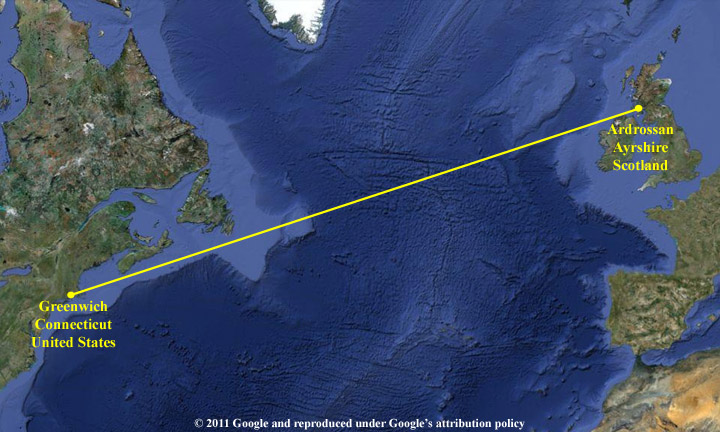
Radio
was becoming established and the American Radio Relay League was keen to know
if transmissions from the United States could be received in Europe. The League
sent one of its members, Paul Godley, to find out. Godley set up a receiver
using a long wire suspended from several poles in a seaweed-covered field on
the North Shore, Ardrossan. He camped in a tent for over a week in a cold, wet
December waiting for his colleagues to make contact. On 11 December 1921, Godley’s
efforts were rewarded when he received amateur shortwave transmissions from
Greenwich, Connecticut on the east coast of America over three thousand miles
away. He also picked up signals from several other stations in the United States
and Canada. Godley is thought to have camped in what was then a field at the
left of the photograph below.
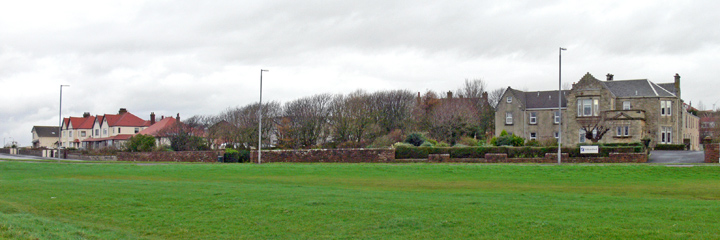
The
building at the right in the photo is Abbotsford. On its front wall is a plaque,
shown below, that commemorates the historical event.
.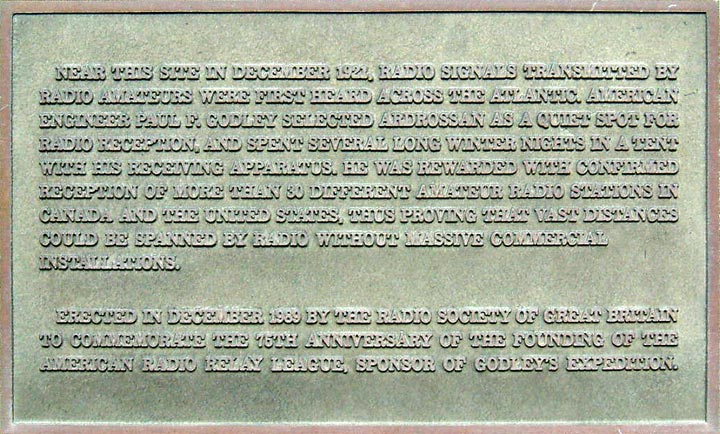
The
text is: Near this site in December 1921, radio signals transmitted by radio
amateurs were first heard across the Atlantic. American engineer Paul F Godley
selected Ardrossan as a quiet spot for radio reception and spent several long
winter nights in a tent with his receiving apparatus. He was rewarded with confirmed
reception of more than 30 different amateur radio stations in Canada and the
United States thus proving that vast distances could be spanned by radio without
massive commercial installations. Erected in December 1989 by The Radio Society
Of Great Britain to commemorate the 75th anniversary of the founding of the
American Radio Relay League, sponsor of Godley's expedition.
The
Ardrossan and Saltcoats Herald reported on the first transmission in its edition
of 16 December 1921 as below.
WIRELESS
IN ARDROSSAN
Successful Tests Across The Atlantic
Messages Received From American Amateurs
Interview With U S Official Observer
“The
name of Ardrossan will go down in the history of the progress of wireless telegraphy
with the great transatlantic wireless tests during the past week.” The
above statement was made by Mr Paul F Godley, a prominent American wireless
expert, to a representative of the Ardrossan and Saltcoats Herald who interviewed
him in Ardrossan on Tuesday evening (13 December 1921). The tests referred to
are a series of experiments which are being conducted by American radio amateurs
for the purpose of proving the capacity of the low-power wireless installation
to which they are restricted by law to bridge the Atlantic.
Upon
Mr Godley’s presence in Ardrossan, there hangs an entirely interesting
story and the outcome of his visit here is more interesting still. In the United
States and Canada, there are about a quarter of a million amateurs possessing
and operating private wireless telegraphic sets and they have a national association
of their own named the American Radio Relay League which by its activities,
including the publication of an excellent monthly magazine, has done much to
popularise ‘citizen radio’ and at the same time help forward wireless
science as a whole. The enthusiastic members of this body are in frequent communication
with each other by wireless over a wide radius in the United States and Canada
but some time ago, they considered the possibility of extending their field
of operations to Europe and last February, the organisation arranged with the
foremost amateurs in Britain to make an attempt to communicate with them. They
transmitted several messages on several nights according to a prearranged schedule
but their efforts to achieve communication were totally unsuccessful. Their
failure, however, did not daunt the amateurs and recently their League appropriated
a sum of money in order to send a prominent representative of American amateurs
to Great Britain as official observer in connection with another series of tests
running from December 7 to December 16, tonight. The representative chosen was
Mr Paul F Godley of Montclair, New Jersey, who is a member of the Advisory Technical
Committee of the League and also a member of the Institute of Radio Engineers
and of the Radio Club of America. Mr Godley, who is well-known in America for
his work in advancing the cause of wireless science among amateurs, after an
exhaustive consideration as to the most suitable place in Britain for ensuring
the success of the experiment, selected Ardrossan.
The
British Marconi Company interested themselves in the tests and their Scottish
representative, Mr Carsewell, introduced Mr Godley to Mr Robert Wood, joint
Town Clerk, Ardrossan, through whose good offices a site for the erection of
the receiving equipment was obtained in the field at the North Shore, Ardrossan
belonging to Mr Hugh Hunter of Montfode. The equipment was installed and since
Wednesday night of last week, Mr Godley assisted by Mr Pearson of the Marconi
Company has been carrying out the tests. According to the prearranged plan each
night during the period of the test, American and Canadian amateurs transmit
message across from 12 midnight to 6 am. The experiment, fortunately, has been
a complete success. On the first night, they were able to pick up only one station
located at Roxbury, Massachusetts. On the second night, owing to electrical
disturbances in the atmosphere, they were unable to get any communication but
every night since that, Mr Godley and his assistant have been in constant touch
with America and up till Tuesday, they had heard thirty-five American amateur
stations and had copied the messages sent. The first message received was one
to congratulations signed by six men prominent in amateur wireless work in America,
one of whom, Mr Armstrong, is famous as a wireless inventor.
One
of the most powerful stations Mr Godley has heard is stationed in Toronto, Canada
and belongs to Mr E S Rodgers, 49 Nanton Avenue, Toronto. The most reliable
station heard is that belonging to an amateur in Greenwich, Connecticut and
the most distant station picked up is that of an amateur in Atlanta, Georgia
about 3600 miles from Ardrossan. The success of this experiment with low-power
wireless is a real step forward in science and it will rebound to the fame of
Ardrossan that it was in this town the official test was made. It is a very
valuable experiment and, apart from its importance to amateurs, it may yet be
the means of enabling economies to be effective in commercial wireless work.
“I
am very pleased with what we have achieved.” said Mr Godley to our representative.
“I consider the experiment has been a great success. One of the things
I hoped for in carrying through the tests was the realisation of the possibility
of American amateurs being able to have nightly talks with their cousins in
the United Kingdom. Of course, the Post Office restrictions on amateurs here
are more severe than in America but I hope that these restrictions may be modified
so as to give an impetus to amateur wireless work in Britain. In America, the
power of the private equipment is restricted to about one kilowatt, the equivalent
of about one and a third horsepower whereas amateurs in Britain are restricted
to one-hundredth part of that power. Commercial stations communicating across
the Atlantic use, on an average, about 250 kilowatts. One of the stations I
have heard located about seventy miles east of New York on Long Island, was
using 26 watts, only double the power permitted in Britain which shows that
there are some possibilities even with the present restrictions. This test has
aroused great interest all over America and also on this side and the interest
has been aroused not only among amateurs. One of the large American corporations,
the Western Electric Company have, in view of the success of the test, sent
me a long cable, requesting me to listen to one of their stations on the night
of the fourteenth when messages will be transmitted between 1 am and 6 am continuously.”.
“I
selected Ardrossan owing to its geographical position. It is convenient to a
large centre and in a straight line between Ardrossan and New York, there is
no high land intervening. The line passes the north end of Arran, crosses the
low part of Kintyre and Islay and then there is an absolutely clear passage.
I am quite certain” said Mr Godley “that if any commercial telegraphic
concerns decided to erect additional stations in Britain for communication with
North America, this particular locality would be chosen, partially as the result
of my success here.”.
The document below, written in 2008, is from www.TeslaInScotland.com
and is reproduced
by kind permission of its website author, A J Morton who owns the copyright.
Nikola
Tesla: The Scottish Connection ARDROSSAN
TRANSMISSIONS The
Transatlantic Tests
In 1921,
an associate of Guglielmo Marconi made his way to an obscure, seaweed-covered
site in Ayrshire in the hope of receiving an amateur short-wave radio transmission
from the U.S.A. If successful, the test would be the world’s first transatlantic
voice message using limited short-wave frequencies. It was known that short-wave
worked well over short distances but the idea that it could be used to send
signals and messages across the Atlantic was, at the time, almost laughable.
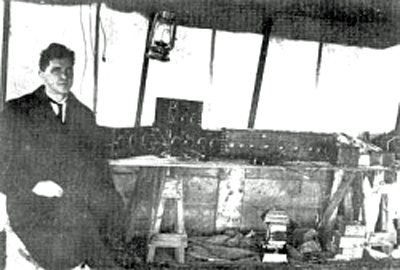 Despite
having little to do with Tesla (in fact the opposite was true), the Transatlantic
tests were an astounding achievement in the history of shortwave radio transmission.
That one half of the experiment was based on the west coast of Scotland is the
reason why it features on these pages.
Despite
having little to do with Tesla (in fact the opposite was true), the Transatlantic
tests were an astounding achievement in the history of shortwave radio transmission.
That one half of the experiment was based on the west coast of Scotland is the
reason why it features on these pages.
A member
of the Marconi International Marine Communications Company (D E Pearson, thought
to be the man in the photograph right) accompanied Paul Godley to a well chosen
spot in Ardrossan. Their task was to set up a practical working receiver station
in Scotland before the first transmission from the U.S.A was broadcast.
Almost
1500 feet of wire, coated with phosphor and bronze, was suspended several feet
above the ground using tall, regularly spaced poles dug deep into the earth.
This alone represents a milestone in British history since it was the first
receiver of its kind (Beverage class) to be used in the United Kingdom.
The low
wattage of short-wave systems meant that signals couldn’t be transmitted
over great distances. By simply increasing the power and the size of the antennae,
the range of short-wave signals could be increased. But the Atlantic was still
a difficult (and apparently impossible) obstacle for the successful passage
of short-wave signals. This was due, in part, to the curvature of the earth
and to the rather strange, and not fully understood, characteristics of short-wave
radio.
In the
early 20th century, short-wave enthusiasts realised that early tests appeared
to work better at certain times of day. Darkness seemed to have an advantageous
effect on many of the experiments. They soon realised they could also use the
ionosphere to refract the transmissions (essentially bouncing the signals about
the atmosphere).
Almost
a century ago, night-owl engineers could be found pushing the limits of radio
all through the early morning (between 00:30AM and 05:00AM). I imagine great
quantities of tea being used to fuel the nocturnal habits of the wavelength
surfers of yesteryear.
The Americans
began regular repeated transmission on December 7th, 1921. They contained, primarily,
a formal message of congratulations to Paul Godley and included the spoken signatures
of a number of illustrious members of the early radio movement (including Edwin
Armstrong, the inventor of FM radio).
Two days
after the transmissions began their loop (each one was accurately time-stamped),
Godley’s radio station in Ardrossan, located in the middle of a seaweed-covered
“field”, received the first words ever transmitted across the Atlantic
using short-wave radio. The first part of that message read, “To Paul Godley
Ardrossan Scotland,” and with it a landmark in radio history was set in
stone forever.
Godley
had installed his equipment in the pouring rain. In December. On the coast.
It would have been freezing. A less comfortable situation can hardly be imagined.
The “field”
his station was constructed on was apparently coated with a layer of seaweed.
He, or someone else, had chosen a stunningly dangerous site for the first transatlantic
tests. The seaweed layer suggests that the area was either tidal (this is unlikely
since Godley is known to have operated the station for a number of days, by
which time the entire site would have been under water several times before
the broadcast could ever be made) or that it was subject to periodic oceanic
storms (which is, as you all probably know, extremely likely in the Ardrossan
area).
Godley,
who was not a native Scot, was lucky to have survived the tests. He narrowly
escaped becoming one of the first radio martyrs and truly deserved the “hearty
congratulations” he received at 00:50AM on a cold December day in Ayrshire.
The Ardrossan
Transmissions were celebrated (and recreated!) by the Irvine Amateur Radio Club
until only very recently. However, the project and the clubs involved have all
closed down. It seems the coming of the Internet has pushed amateur radio onto
the back-burner. How unfortunate it is that the celebration of the Ardrossan
Transmissions has been forced to join it.
Nikola Tesla (10 July 1856 to 7 January 1943) was an inventor and a mechanical
and electrical engineer. He was one of the most important contributors to the
birth of commercial electricity and is best known for his many revolutionary
developments in the field of electromagnetism in the late nineteenth and early
twentieth centuries. His biography can be read here.




 Despite
having little to do with Tesla (in fact the opposite was true), the Transatlantic
tests were an astounding achievement in the history of shortwave radio transmission.
That one half of the experiment was based on the west coast of Scotland is the
reason why it features on these pages.
Despite
having little to do with Tesla (in fact the opposite was true), the Transatlantic
tests were an astounding achievement in the history of shortwave radio transmission.
That one half of the experiment was based on the west coast of Scotland is the
reason why it features on these pages.